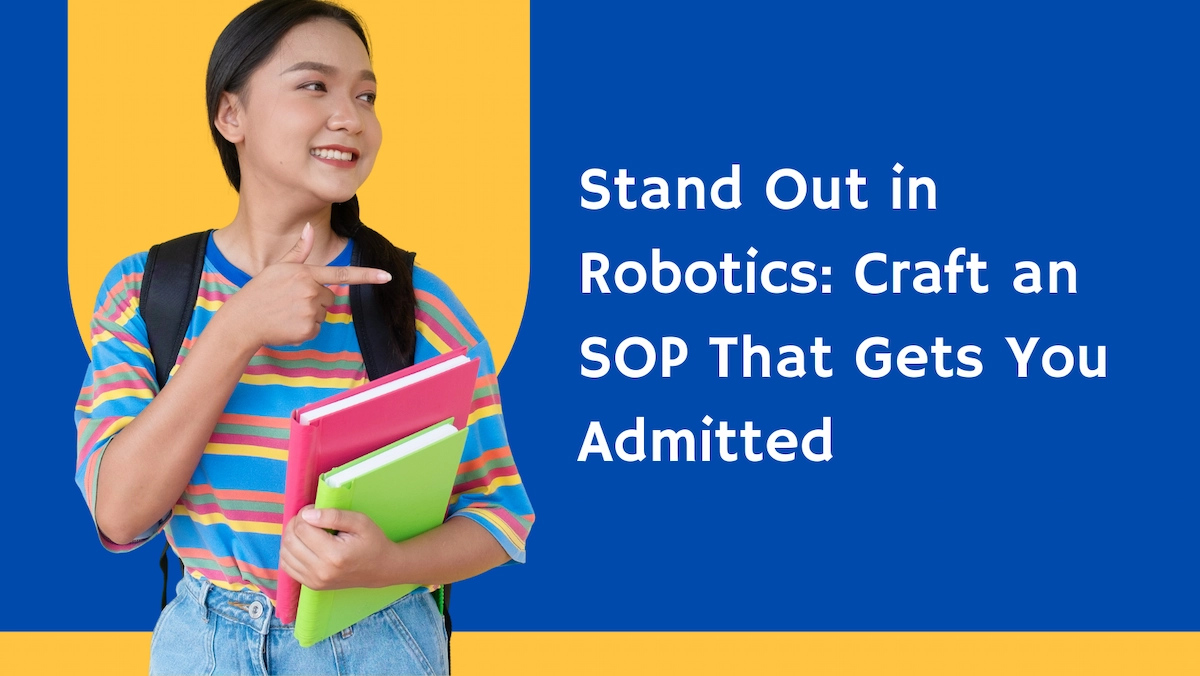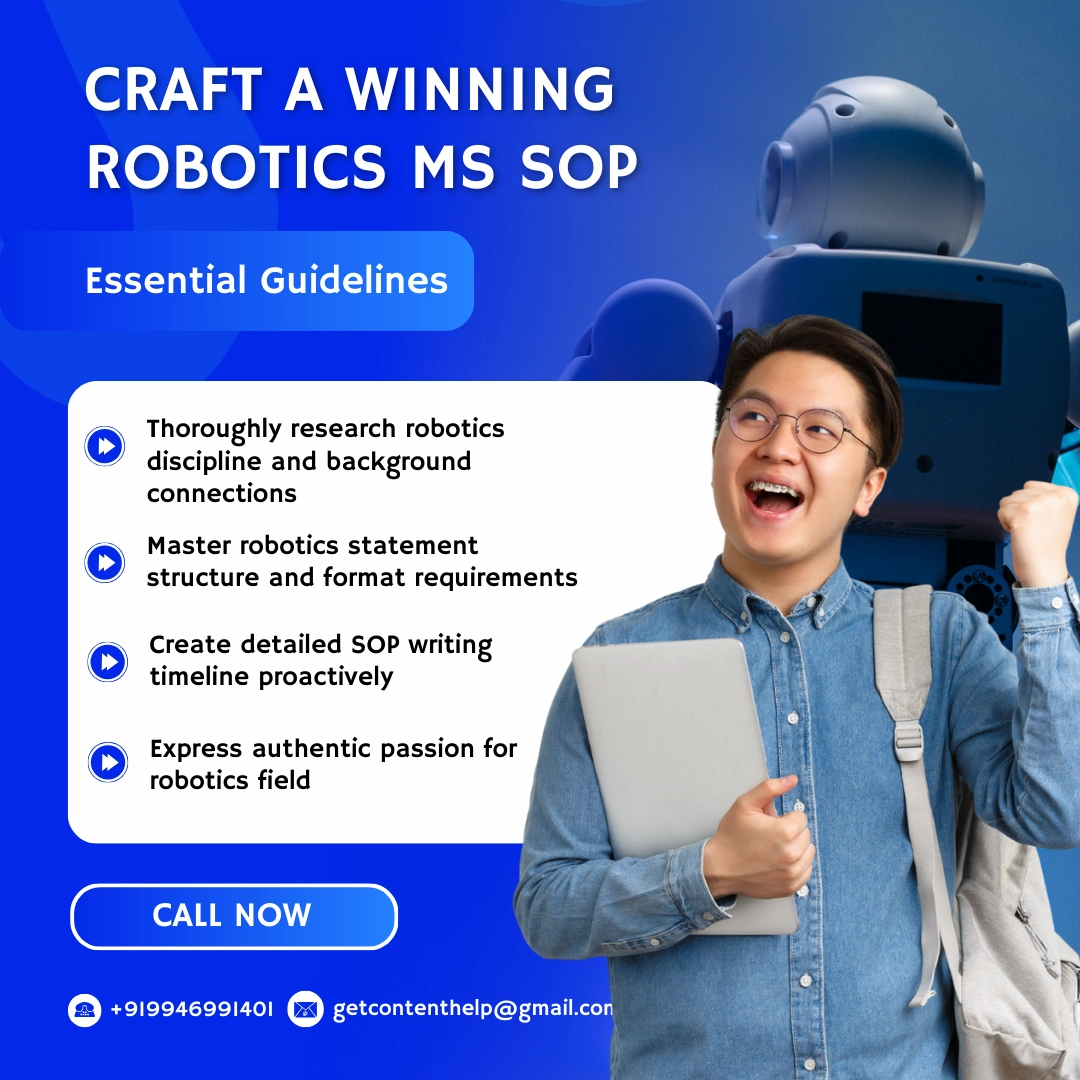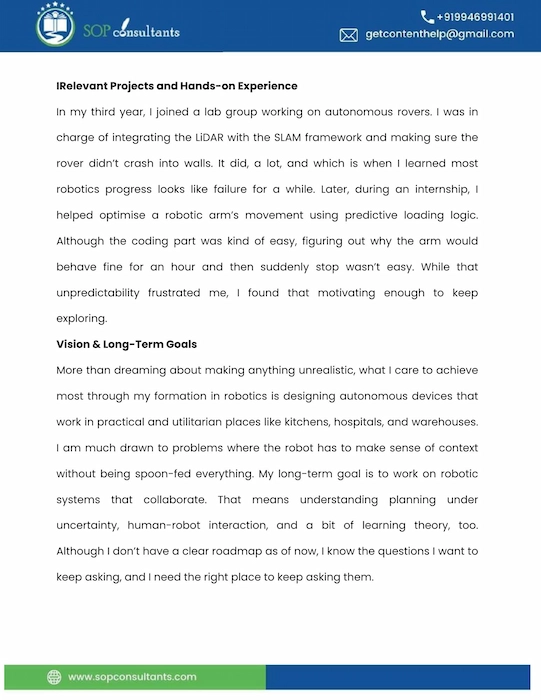
If you are interested in pursuing a career in robotics and getting formal training from a reputed institution, ambition alone isn’t enough. You must show how your ideas connect with the field through a contextualised SOP for Robotics that positions you well within it. This blog explains how to draft such a document.
A personal statement for robotics is a narrative document that you, as an applicant of this discipline, need to use to show that you are not taking this program out of vague interest but with a clear sense of direction. The document is a solid reflection of your intellectual trajectory and how you place yourself in the broader landscape of robotics.
Given the importance of a statement of purpose for robotics in a student’s admission to prestigious programs like ETH Zurich or TU Delft, it cannot be treated lightly. You must approach it as both a personal narrative and a technical positioning document. Here are the basic guidelines to get started.

Introduction
I didn’t start out thinking I would end up in robotics. It began more as a side effect of liking systems that behave, misbehave, and then learn. At first, my attention was caught by circuits doing what you tell them. But the deeper I went, the more I cared about the gap between what we tell machines and what they understand. I then realised that the gap was conceptual more than technical. And that’s exactly what pulled me into the field. The more I worked, the more I realised robotics was essentially getting them to think in useful ways, even if they don’t think at all.
Educational Background and Skills
I studied Electronics and Instrumentation Engineering. Most of it was about signal conditioning, control systems, and sensor tech. By my second year, I started investing more time to understand microcontrollers and feedback loops more seriously. I didn’t really like theoretical derivations unless I could wire something up and watch it behave differently due to changes in parameters. Then, eventually, I got comfortable with C++, Python, and MATLAB as I found them to be the shortest path to making things move when I wanted them to. I wouldn’t call myself a software person, but I like writing code that does something physical, especially when it is not obvious what it is supposed to do.
Relevant Projects and Hands-on Experience
In my third year, I joined a lab group working on autonomous rovers. I was in charge of integrating the LiDAR with the SLAM framework and making sure the rover didn’t crash into walls. It did, a lot, and which is when I learned most robotics progress looks like failure for a while. Later, during an internship, I helped optimise a robotic arm’s movement using predictive loading logic. Although the coding part was kind of easy, figuring out why the arm would behave fine for an hour and then suddenly stop wasn’t easy. While that unpredictability frustrated me, I found that motivating enough to keep exploring.
Vision & Long-Term Goals
More than dreaming about making anything unrealistic, what I care to achieve most through my formation in robotics is designing autonomous devices that work in practical and utilitarian places like kitchens, hospitals, and warehouses. I am much drawn to problems where the robot has to make sense of context without being spoon-fed everything. My long-term goal is to work on robotic systems that collaborate. That means understanding planning under uncertainty, human-robot interaction, and a bit of learning theory, too. Although I don’t have a clear roadmap as of now, I know the questions I want to keep asking, and I need the right place to keep asking them.
Reason for Choosing this Program/Institute
Most programs treat robotics like a subset of mechanical or electrical engineering. What I like about [University Name] is that it treats robotics as its own field. I have read Professor [X]’s work on adaptive motion planning, and it’s one of the few things I have come across that doesn’t try to oversimplify the problem. I also like that the lab setups here encourage students not just to test what already works, but also to break things that don’t and figure out why. That kind of environment is exactly where I want to be.



The structure and important points to discuss in an SOP for robotics are explained below. As you draft your document, make sure it contains this information in the given order to make it compatible with the institute’s expectations.
The Introduction is the most powerful section in a personal statement for robotics. Write it as a launchpad to start your story and give the reader the context of why you belong to this discipline.
Your relevant academic background and core skills that will make you suitable for a career in robotics will be evaluated to determine your candidacy. So write about these areas with verifiable points.
Here, write about projects you headed with major contributions, both during the formative years and in internships or jobs. If you have any hands-on experience in a related area of robotics, write about that as well.
Admissions teams want to know where you are headed and how robotics fits into your broader ambitions. Write about your long-term goals, whether in research, industry, or innovation, and how the program will help shape that path.
Avoiding general praise, highlight specific aspects of the program, like labs, faculty, coursework, or institutional focus, that directly match your interests and goals. Show that you have made this choice intentionally after research.
We hope you found this blog on how to write SOP for robotics helpful.
Are you ready to start preparing the document now?
Preparation and planning are the key to writing a successful personal statement, not just for robotics but for any program.
If you are facing any roadblock and need expert advice to move forward, always count on SOP Consultants for personalised help.
When aiming for a seat in robotics, it is important to submit a well-crafted SOP to show that you are not taking this program just as a choice but rather out of true passion. While your academic credentials and certifications show only the quantitative side of you, an SOP can show the qualitative, like your goals, motivation and creative thinking.
Yes, if you are seeking entry into robotics from a reputed institution where the total number of applications exceeds the number of available seats. When there are multiple qualified applicants, institutions put so much weight on the SOP to determine the most eligible ones.
Essentially, you need to touch on your academic background, technical skills, projects, career goals, and reasons for choosing the program in your personal statement for robotics. Don’t forget to link each of these points to robotics as a discipline.
With a reliable SOP writing service like SOP consultants, you can get a professionally written SOP for robotics in 4 to 7 days. If you have more urgency, you can use their express delivery option.

Vasuki Ram, senior writer and the founder of SOP Consultants is a B-tech Graduate who used to work in an MNC. Starting from 2013, she along with her team has assisted more than 10,000 students. Shift in her career was drastic. Read full story here.

© Copyright 2025 SOP Consultants | Designed by 3CBrandHub

© Copyright 2024 SOP Consultants | Designed by 3CBrandHub